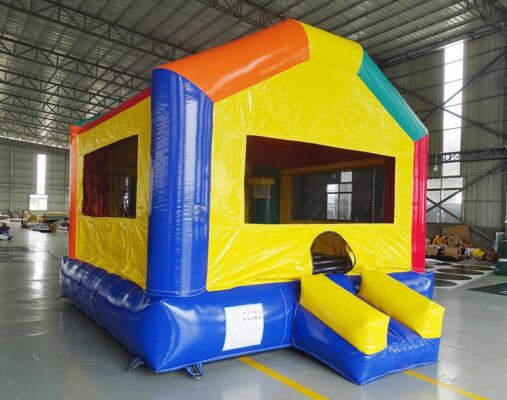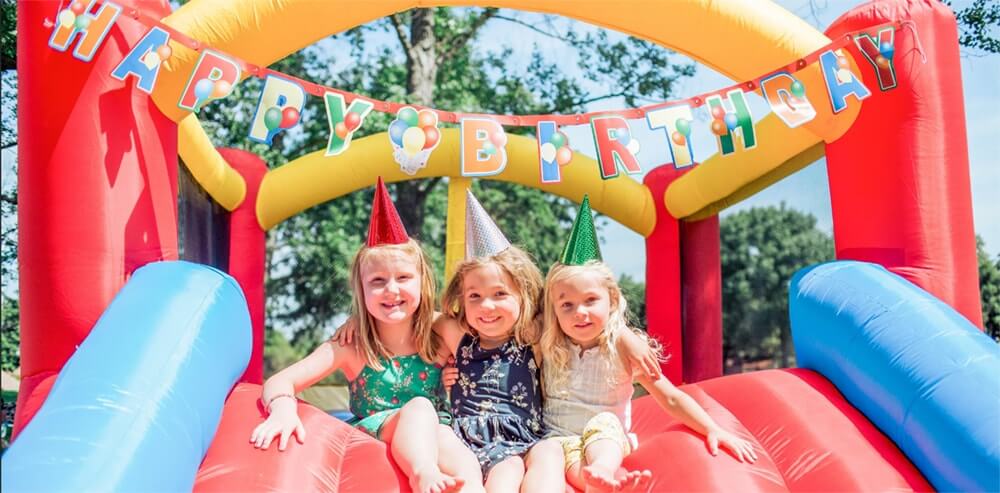การกระโดดเข้าสู่โลกของตุ๊กตาเป่าลมอาจเป็นการผจญภัยที่น่าตื่นเต้น แต่คุณจะเลือกระหว่างตุ๊กตาเป่าลมสำหรับที่พักอาศัยและเชิงพาณิชย์ได้อย่างไร อย่ากลัวเลย ผู้อ่านที่รัก ในขณะที่เราแนะนำคุณตลอดกระบวนการนี้ กระโดดเข้าไปเลย!
ที่นอนเป่าลมสำหรับที่พักอาศัย: สำหรับ Bouncers ขนาดเล็กที่บ้าน

ซึ่งทำให้พองได้ที่อยู่อาศัยเหมาะสำหรับลูกน้อยของคุณโดยเฉพาะสำหรับใช้ในบ้าน เหมาะสำหรับเด็ก เด็กเล็ก และทารก โดยทำจากวัสดุไนลอนน้ำหนักเบาหรือผ้าอ็อกซ์ฟอร์ด ซึ่งหมายความว่ามีอายุการใช้งานไม่นานที่สุด เรามาดูรายละเอียดคุณสมบัติที่สำคัญของพองสำหรับที่พักอาศัยกัน:
- วัตถุประสงค์: ใช้ในบ้าน
- ใครสามารถเล่นได้: เด็ก เด็กเล็ก ทารก
- วัสดุ: ผ้า Oxford หรือวัสดุไนลอน
- ขนาด: ขนาดเล็ก ขนาดไม่เกิน 20 ตร.ม./215 ฟุต²
- น้ำหนัก: 8 กก. – 40 กก
- ราคา: ไม่เกิน 500 เหรียญสหรัฐ
- อายุการใช้งาน: 6 เดือนถึง 1 ปี ขึ้นอยู่กับความถี่ในการใช้งาน
พองลมสำหรับที่พักอาศัยมีจำหน่ายที่ซูเปอร์มาร์เก็ต เช่น Walmart และ Target เครือข่ายร้านค้าปลีก ผู้ค้าปลีกออนไลน์ เช่น Amazon และ eBay และผู้ผลิตเช่นเรา
ซึ่งทำให้พองได้เชิงพาณิชย์: นำปาร์ตี้สู่สาธารณะ

ซึ่งทำให้พองได้เชิงพาณิชย์ในทางกลับกัน ได้รับการออกแบบมาเพื่อการใช้งานหนักในเชิงพาณิชย์ เหมาะสำหรับทั้งเด็กและผู้ใหญ่ พองลมเหล่านี้ทำจากวัสดุพีวีซีคุณภาพสูง ปราศจากสารตะกั่ว และทนไฟ จึงมั่นใจได้ถึงความทนทานและความปลอดภัย มาดำดิ่งสู่โลกแห่งพองลมเชิงพาณิชย์:
- วัตถุประสงค์: ใช้ในเชิงพาณิชย์
- ใครสามารถเล่นได้: เด็กและผู้ใหญ่
- วัสดุ: 15 ออนซ์ & ไวนิล (PVC) 18 ออนซ์), แผ่นกั้นไวนิล 10 ออนซ์ด้านใน
- ขนาด: ขนาดใหญ่ ปกติแล้วจะใหญ่กว่า 10 ตร.ม./108 ตร.ฟุต
- น้ำหนัก: >= 40 กก
- ราคา: โดยปกติ >= 500 ดอลลาร์สหรัฐ
- อายุการใช้งาน: อย่างน้อย 2 ปี
- สั่งซื้อและผลิต: การปรับแต่ง
พองลมเชิงพาณิชย์จำหน่ายผ่านเว็บไซต์ของผู้ผลิตและการติดต่อโดยตรงอื่นๆ
รายการเปรียบเทียบ: ซึ่งทำให้พองได้สำหรับที่อยู่อาศัยและเชิงพาณิชย์
| หมวดหมู่ | ซึ่งทำให้พองได้ที่อยู่อาศัย | ซึ่งทำให้พองได้เชิงพาณิชย์ |
|---|---|---|
| วัตถุประสงค์ | ใช้ในบ้าน | ใช้ในเชิงพาณิชย์ ให้เช่า จัดงานอีเว้นท์ |
| ผู้ใช้ | เด็กๆ เด็กเล็ก | เด็กและผู้ใหญ่ |
| วัสดุ | ผ้า Oxford หรือวัสดุไนลอน | 15 ออนซ์ & ไวนิล PVC 18 ออนซ์, แผ่นกั้นไวนิล 10 ออนซ์ด้านใน |
| ขนาด | ขนาดเล็ก ไม่เกิน 20 ตร.ม. (215 ฟุต²) | ขนาดใหญ่ ปกติแล้วจะใหญ่กว่า 10 ตร.ม. (108 ฟุต²) |
| น้ำหนัก | 8 กก. – 40 กก | >= 40 กก |
| ราคา | ไม่เกิน 500 เหรียญสหรัฐ | >= 500 ดอลลาร์สหรัฐ |
| ความทนทาน & อายุการใช้งาน | อยู่ได้นาน 6 เดือน ถึง 1 ปี | มีอายุอย่างน้อย 2 ปี |
| คำสั่ง & ผลิต | การสั่งซื้อจำนวนมากและการผลิตแบบไหล | การปรับแต่ง |
| ลูกค้า | ผู้ค้าปลีก ผู้ค้าส่ง ผู้จัดจำหน่าย ผู้ปกครอง ฯลฯ | บริษัทให้เช่าเป่าลม สวนสนุก ฯลฯ |
| ช่องทางการขาย | ซูเปอร์มาร์เก็ต เครือร้านค้าปลีก ผู้ค้าปลีกออนไลน์ | เว็บไซต์ผู้ผลิตเป่าลม ติดต่อโดยตรง |
การเลือกเครื่องเป่าลมให้เหมาะสม: Battle of the Bouncers
ตอนนี้เราได้แจกแจงข้อแตกต่างที่สำคัญระหว่างที่นอนเป่าลมสำหรับที่พักอาศัยและเชิงพาณิชย์แล้ว มาช่วยคุณเลือกแบบที่สมบูรณ์แบบกันดีกว่า!
งบประมาณ: หากคุณกำลังมองหาตัวเลือกที่ประหยัดงบ พองสำหรับที่พักอาศัยคือคำตอบของคุณ ราคาถูกกว่าแต่อย่าคาดหวังให้คงอยู่ตลอดไป ในทางกลับกัน พองเชิงพาณิชย์มีราคาแพงกว่าแต่สร้างมาให้มีอายุการใช้งานยาวนาน
การใช้งาน: หากคุณต้องการเป่าลมเพื่อความสนุกสนานในสวนหลังบ้านเป็นครั้งคราว เป่าลมสำหรับที่พักอาศัยก็เพียงพอแล้ว แต่ถ้าคุณวางแผนจะใช้บ่อยๆ หรือเช่าเพื่อทำกิจกรรมต่างๆ ให้เลือกเป่าลมเชิงพาณิชย์
ขนาดและพื้นที่: พองสำหรับที่พักอาศัยมีขนาดเล็กลงและเหมาะสำหรับพื้นที่จำกัด หากคุณมีพื้นที่ขนาดใหญ่และต้องการพองลมที่มีคุณสมบัติมากกว่า พองเชิงพาณิชย์คือตัวเลือกที่ดีกว่า
จำกัดอายุและน้ำหนัก: พองสำหรับที่พักอาศัยออกแบบมาสำหรับเด็กเล็กและมีข้อจำกัดด้านน้ำหนักที่ต่ำกว่า พองลมเชิงพาณิชย์เหมาะสำหรับทั้งเด็กและผู้ใหญ่ โดยสามารถรองรับน้ำหนักที่จำกัดได้
คุณภาพและความทนทาน: คุณได้สิ่งที่คุณจ่ายไป พองสำหรับที่อยู่อาศัยมีอายุการใช้งานสั้นลงเนื่องจากวัสดุน้ำหนักเบา พองลมเชิงพาณิชย์ที่มีโครงสร้างพีวีซีสำหรับงานหนักถูกสร้างขึ้นมาให้มีอายุการใช้งานยาวนาน
หาซื้อได้ที่ไหน: หากคุณต้องการความสะดวก คุณสามารถซื้อพองสำหรับที่พักอาศัยได้ง่ายๆ ที่ร้านค้าปลีกหรือทางออนไลน์ สำหรับเป่าลมเชิงพาณิชย์ ให้สัมผัสโดยตรงกับ ผู้ผลิต เป็นเส้นทางที่ดีที่สุด
โดยสรุป การตัดสินใจระหว่างพองสำหรับที่พักอาศัยและเชิงพาณิชย์นั้นขึ้นอยู่กับความต้องการ งบประมาณ และพื้นที่ของคุณ ลองนึกถึงความถี่ที่คุณจะใช้ลูกโป่ง ใครจะเป็นคนใช้ และคุณจะติดตั้งที่ไหน เมื่อพิจารณาปัจจัยเหล่านี้และชั่งน้ำหนักข้อดีและข้อเสีย คุณจะมีความพร้อมที่จะตัดสินใจได้ถูกต้องสำหรับความต้องการที่เพิ่มขึ้นของคุณ
ปลอดภัยไว้ก่อน: เด้งอย่างมีความรับผิดชอบ

ไม่ว่าคุณจะเลือกพองลมสำหรับที่อยู่อาศัยหรือเชิงพาณิชย์ ควรให้ความสำคัญกับความปลอดภัยเป็นอันดับแรกเสมอ ปฏิบัติตามหลักเกณฑ์ของผู้ผลิตในการตั้งค่าเพื่อให้แน่ใจว่าผู้เล่นทุกคนจะได้รับประสบการณ์ที่สนุกสนานและปราศจากอาการบาดเจ็บ:
- การกำกับดูแล: ตรวจสอบให้แน่ใจเสมอว่ามีผู้ใหญ่คอยดูแลเด็กๆ ขณะที่พวกเขากำลังเล่นในบ้านเด้งดึ๋ง ซึ่งจะช่วยป้องกันอุบัติเหตุและช่วยให้เด็กๆ ใช้พองได้อย่างปลอดภัย
- ข้อจำกัดด้านอายุและขนาด: ปฏิบัติตามหลักเกณฑ์ด้านอายุและขนาดที่ผู้ผลิตกำหนด แนวปฏิบัติเหล่านี้มีไว้เพื่อปกป้องความปลอดภัยของเด็กๆ ที่ใช้บ้านตีกลับ
- จำนวนผู้เข้าพักจำกัด: หลีกเลี่ยงการทำให้บ้านตีกลับแออัดจนเกินไป ปฏิบัติตามขีดจำกัดจำนวนผู้เข้าพักสูงสุดที่แนะนำโดยผู้ผลิต เพื่อป้องกันอุบัติเหตุที่เกิดจากการชนและการล้ม
- การยึดที่เหมาะสม: ตรวจสอบให้แน่ใจว่าบ้านเด้งนั้นยึดอยู่กับพื้นอย่างแน่นหนาโดยใช้หลักหรือกระสอบทราย ซึ่งจะช่วยป้องกันไม่ให้พองลมพลิกคว่ำหรือถูกลมพัดปลิวไป
- สภาพอากาศ: อย่าใช้บ้านเด้งในระหว่างสภาพอากาศที่รุนแรง เช่น ฝนตกหนัก ลมแรง หรือพายุฝนฟ้าคะนอง สภาวะเหล่านี้อาจทำให้ความปลอดภัยและเสถียรภาพของพองลมลดลง
- การแต่งกายที่เหมาะสม: ตรวจสอบให้แน่ใจว่าเด็กๆ ถอดรองเท้า แว่นตา เครื่องประดับ หรือของมีคมอื่นๆ ก่อนเข้าบ้านเด้ง สิ่งของเหล่านี้อาจทำให้เกิดการบาดเจ็บหรือทำให้พองเสียหายได้
- ไม่มีการเล่นแบบหยาบ: ส่งเสริมให้เด็กหลีกเลี่ยงการเล่นที่รุนแรง เช่น การผลัก การผลัก หรือการต่อสู้ ขณะอยู่ในบ้านเด้ง ซึ่งอาจนำไปสู่การบาดเจ็บและอุบัติเหตุได้
- ไม่มีอาหารหรือเครื่องดื่ม: เก็บอาหาร เครื่องดื่ม และหมากฝรั่งให้ห่างจากบ้านเด้ง เพื่อหลีกเลี่ยงอันตรายจากการสำลัก และป้องกันความเสียหายต่อพอง
- ไม่มีการตีลังกาหรือกายกรรม: กีดกันเด็กๆ ไม่ให้ตีลังกา ตีลังกา หรือแสดงกายกรรมอื่นๆ ในบ้านตีกลับ เนื่องจากอาจทำให้เกิดการบาดเจ็บสาหัสได้
- การบำรุงรักษาพอง: ตรวจสอบบ้านตีกลับเป็นประจำเพื่อดูร่องรอยความเสียหายหรือการสึกหรอ แก้ไขปัญหาใดๆ โดยทันทีเพื่อรักษาความปลอดภัยและความสมบูรณ์ของพอง
- การลงจอดแบบกันกระแทก: วางเสื่อนุ่มๆ หรือแผ่นรองลงจอดที่ด้านล่างของสไลเดอร์เป็นความคิดที่ดีเพื่อเพิ่มความปลอดภัย เนื่องจากบ้านเด้งบางหลังไม่มีพื้นที่กันกระแทกดังกล่าว แผ่นรองเพิ่มเติมนี้สามารถช่วยดูดซับแรงกระแทกและป้องกันการบาดเจ็บเมื่อเด็กลงสู่พื้นเมื่อสิ้นสุดสไลเดอร์ ตรวจสอบให้แน่ใจว่าเสื่อมีความหนาเพียงพอที่จะรองรับแรงกระแทกได้เพียงพอ และยึดให้เข้าที่เพื่อให้แน่ใจว่าเสื่อจะไม่ขยับขณะใช้งาน มาตรการความปลอดภัยพิเศษนี้จะช่วยสร้างประสบการณ์ที่สนุกสนานและปลอดภัยยิ่งขึ้นให้กับเด็กๆ ที่ใช้บ้านตีกลับ
และจำไว้ว่าไม่ว่าคุณจะเลือกเป่าลมแบบใด สิ่งที่สำคัญที่สุดคือต้องระเบิดให้สุด! บ้านเด้ง สไลเดอร์น้ำ และด่านสิ่งกีดขวางสามารถสร้างความทรงจำอันน่าจดจำทั้งสำหรับเด็กและผู้ใหญ่ ดังนั้นไปข้างหน้าและปล่อยให้ความเป็นเด็กในตัวคุณทะยานขึ้นไปอย่างมีความสุข!
